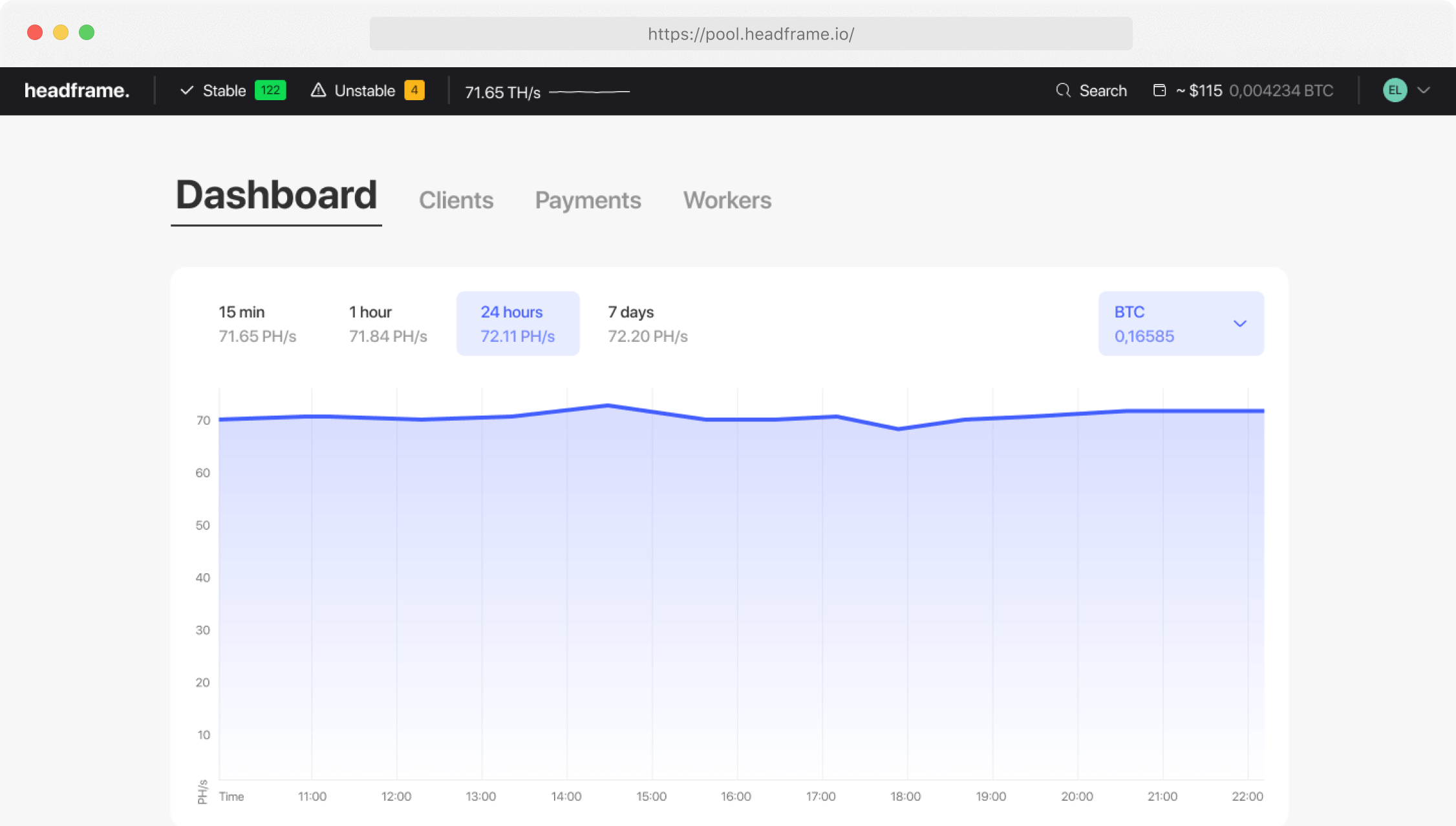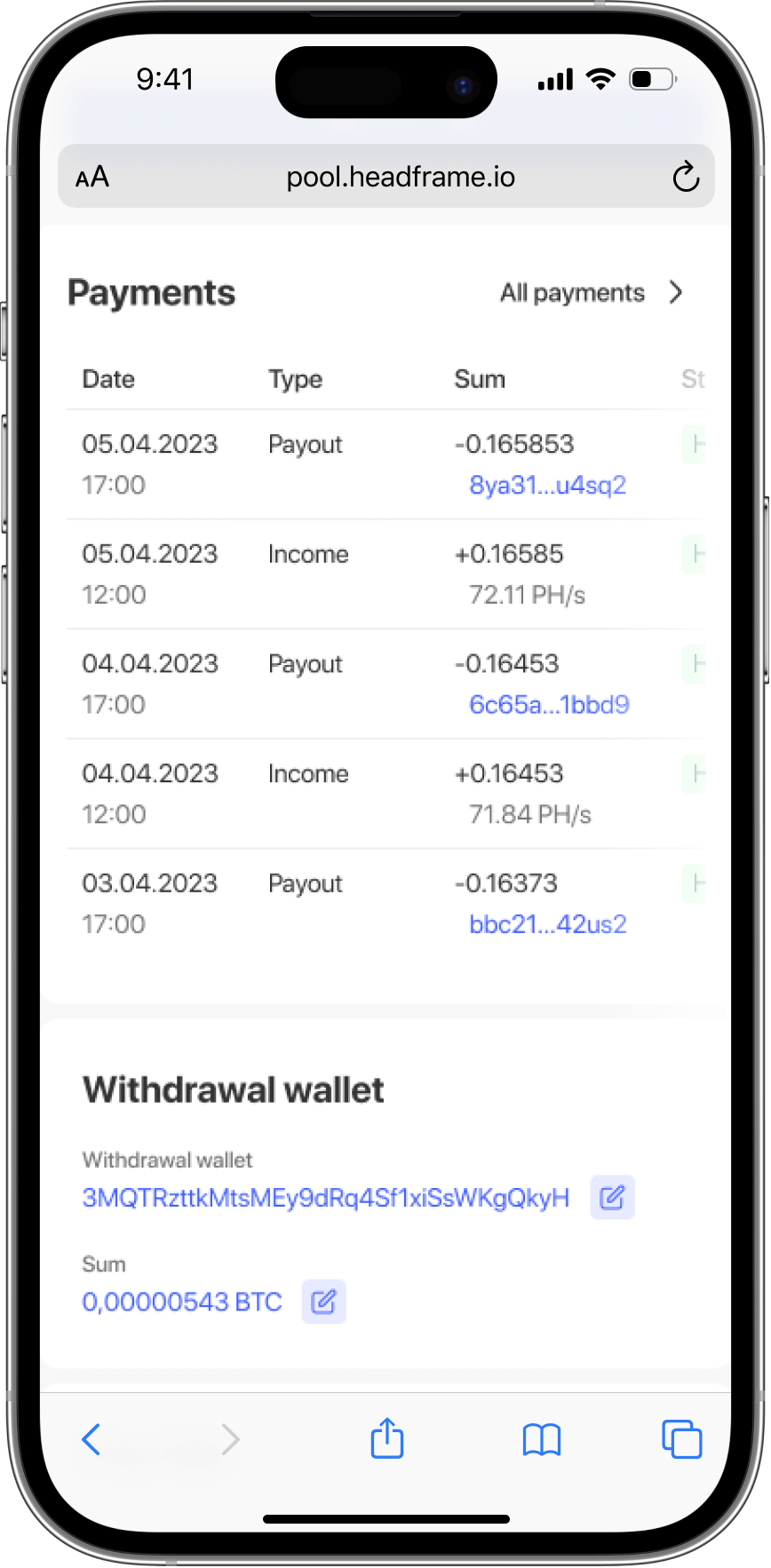The Relationship Between Mining Pools and Cryptocurrency Wallets
Mining pools and cryptocurrency wallets play key roles in the cryptocurrency ecosystem, providing efficient mining and secure storage of digital assets. Understanding the interconnection between these elements is crucial for comprehending how they interact and how this impacts user security, efficiency, and convenience. Let’s explore how mining pools and cryptocurrency wallets work together to ensure reliable and productive operations in the cryptocurrency world.
Earn more money with Headframe
Join a mining pool and get the best profitability in mining. Already more than 10,000 miners trust Headframe.
Mining pools are associations of miners who collaboratively work on mining cryptocurrencies, sharing computational power and rewards. This allows participants to earn more stable incomes compared to solo mining. When miners join a pool, they increase their chances of finding new blocks, making the mining process more predictable and profitable. After a new block is found, the reward is distributed among the pool participants proportionally to their contribution to the total computational power.
On the other hand, cryptocurrency wallets are designed for the secure storage, sending, and receiving of cryptocurrencies. They provide users with access to their digital assets, allowing them to manage their funds using unique cryptographic keys. There are several types of cryptocurrency wallets, including hardware, software, mobile, and web wallets, each with its features and levels of security.
The interconnection between mining pools and cryptocurrency wallets begins with the process of mining and distributing rewards. When miners participate in a pool, they register their cryptocurrency wallets to receive payouts. After a new block is found, the pool distributes the rewards among the participants, sending the respective amounts to their wallets. This process requires reliable and secure integration between the pool and wallets to ensure rewards are delivered correctly and protected from potential threats.
Security
One of the key aspects of this interconnection is security. Pools and wallets must use advanced encryption and data protection methods to prevent unauthorized access and theft of funds. Wallets provide security through cryptographic keys stored in secure locations and used to sign transactions. Mining pools, in turn, must secure their servers and databases to prevent attacks and data leaks.
User Convenience
User convenience is also an important factor in the interconnection between mining pools and cryptocurrency wallets. Miners should be able to easily connect their wallets to the pool, receive payouts, and manage their funds. Intuitive interfaces and support for various types of wallets improve the user experience. Pools should provide miners with access to information about their earnings, mining statistics, and payout settings through convenient dashboards and mobile applications.
Technological Innovations
Technological innovations play a significant role in enhancing the interconnection between mining pools and cryptocurrency wallets. The implementation of smart contracts and decentralized finance (DeFi) applications allows for the automation of many processes and improves transparency. Smart contracts can be used to automatically distribute rewards and manage payouts, reducing the risk of errors and fraud. DeFi applications provide additional opportunities for miners, such as staking and lending, allowing them to increase their income and improve asset management.
Regulatory Aspects
Regulatory aspects also play a crucial role in the interconnection between mining pools and cryptocurrency wallets. Different countries have various laws and regulations concerning the use of cryptocurrencies, and pools and wallets must comply with these regulatory acts. Adhering to all legislative requirements helps avoid legal issues and ensures the legitimacy of operations. Transparency and compliance with regulatory requirements also strengthen the trust of participants and investors, contributing to stability and income growth.
Educational Initiatives
Educational initiatives and upskilling participants are also important for enhancing the interconnection between mining pools and cryptocurrency wallets. Training miners and wallet users in new methods and technologies helps improve their skills and knowledge, leading to more efficient work and increased income. Educational programs and training sessions help participants better understand and use modern technologies to optimize their operations. This promotes more responsible and informed participation in mining operations, improving their overall efficiency and stability.
Partnerships and Collaboration
Partnerships and collaboration between mining pools and cryptocurrency wallet developers also play a crucial role in enhancing the interconnection. Combining efforts and sharing knowledge and resources help accelerate the development and implementation of new technologies. Partnership relationships foster the creation of a global ecosystem where innovations can quickly spread and adapt to various conditions. This contributes to the overall efficiency and sustainability of mining operations.
Advanced Technologies
The use of advanced technologies and innovations is a key element in the interconnection between mining pools and cryptocurrency wallets. Implementing new mining algorithms, such as Proof of Stake (PoS) and hybrid models, helps increase efficiency and reduce costs. Modern energy management technologies and the use of renewable energy sources help reduce costs and improve the environmental sustainability of mining operations. Investments in research and development ensure the pool’s competitiveness and sustainable growth.
Social and Environmental Responsibility
Social and environmental responsibility is also important for mining pools and wallets. Supporting environmental initiatives and using renewable energy sources help reduce the carbon footprint of mining operations and improve their environmental sustainability. Participation in social projects and supporting local communities also strengthen ties with participants and improve their trust in the pool. This helps create a more sustainable and inclusive cryptocurrency ecosystem.
In conclusion, the interconnection between mining pools and cryptocurrency wallets is a complex and multi-layered system that includes various levels of management, technology, and participant interaction. The founders and management team, technical support and maintenance, software, financial management, participant interaction, educational initiatives, regulatory compliance, partnerships, and the use of advanced technologies play key roles in the successful operation and development of mining pools and wallets. Understanding these structures helps better comprehend how mining pools and cryptocurrency wallets function, how they distribute resources and rewards, and what role they play in ensuring the stability and efficiency of cryptocurrency networks.


